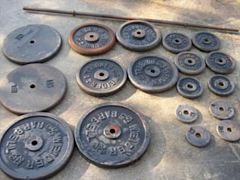 This month's article collaborations with Run to Win's Blaine Moore will centre around training equipment. Before we get into the articles themselves, a few definitions are in order.
This month's article collaborations with Run to Win's Blaine Moore will centre around training equipment. Before we get into the articles themselves, a few definitions are in order.
If you'd like to suggest an addition or change to this list, either leave a note in the comments or drop me a line.
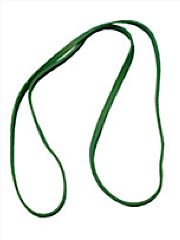 bands : along with chains, bands are the usual method of employing 'accommodating resistance'. This simply means that the weight gradually increases throughout the concentric part of the lift; as well as making the eccentric part a little more difficult.
bands : along with chains, bands are the usual method of employing 'accommodating resistance'. This simply means that the weight gradually increases throughout the concentric part of the lift; as well as making the eccentric part a little more difficult.
If you haven't seen them before, picture a normal elastic band blown up until it's about 6' in diameter (and extremely strong, of course). Fantastic things.
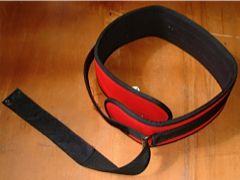 belt : a weight belt serves two main purposes [1]. The first is to reduce stress on the lower back whilst the lifter is working in an upright position, the second is to prevent hyperextension of the back during overhead lifts.
belt : a weight belt serves two main purposes [1]. The first is to reduce stress on the lower back whilst the lifter is working in an upright position, the second is to prevent hyperextension of the back during overhead lifts.
As with weightlifting gloves, the belt is often used - if at all - for the heavier sets only.
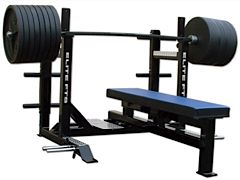 bench : along with the power rack, the bench forms the hub of many a home gym. If you're wondering why you can't simply lie on the floor for your pressing work, you can; the bench, however, affords a greater range of motion and allows for the benefit of leg drive.
bench : along with the power rack, the bench forms the hub of many a home gym. If you're wondering why you can't simply lie on the floor for your pressing work, you can; the bench, however, affords a greater range of motion and allows for the benefit of leg drive.
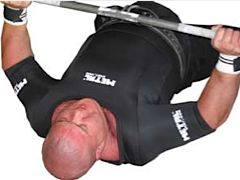 bench shirt : this is an item used by some powerlifters (it's why you'll hear things such as a 'shirted bench'). The bench shirt is a tight, dedicated garment which acts much like a rubber band - making it a little more difficult to pull the bar down to your chest, but easier to press the bar back up again. A shirted bench is typically 100lb or more above a raw (or unshirted) bench.
bench shirt : this is an item used by some powerlifters (it's why you'll hear things such as a 'shirted bench'). The bench shirt is a tight, dedicated garment which acts much like a rubber band - making it a little more difficult to pull the bar down to your chest, but easier to press the bar back up again. A shirted bench is typically 100lb or more above a raw (or unshirted) bench.
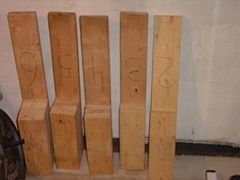 boards : boards are used for board pressing, a bench press variation which allows the training of specific ranges of motion. Wooden boards of the desired thickness (usually between 4 and 14 inches) are held over the chest during a bench press, and the bar is brought down until it touches the board.
boards : boards are used for board pressing, a bench press variation which allows the training of specific ranges of motion. Wooden boards of the desired thickness (usually between 4 and 14 inches) are held over the chest during a bench press, and the bar is brought down until it touches the board.
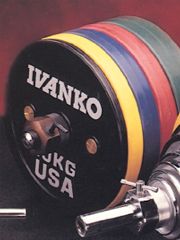 bumper plates : these are used (usually in conjunction with a lifting platform) for Olympic lifting. They can either be rubber coated or completely made from rubber, and are calibrated, quality plates that are made to take a little more abuse (from dropping) than regular plates. Note that this dropping is generally from knee height or below.
bumper plates : these are used (usually in conjunction with a lifting platform) for Olympic lifting. They can either be rubber coated or completely made from rubber, and are calibrated, quality plates that are made to take a little more abuse (from dropping) than regular plates. Note that this dropping is generally from knee height or below.
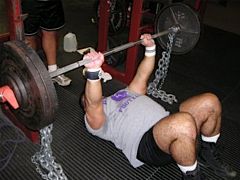 chains : like bands, chains offer accommodating resistance. A common use is with the bench press, where they are draped over the ends of the bar so that only a small portion rests on the floor. As the bar is lowered, this amount increases (gradually increasing the weight being lifted); lowering again as the bar is pressed.
chains : like bands, chains offer accommodating resistance. A common use is with the bench press, where they are draped over the ends of the bar so that only a small portion rests on the floor. As the bar is lowered, this amount increases (gradually increasing the weight being lifted); lowering again as the bar is pressed.
Unlike bands, the resistance changes gradually through both eccentric and concentric parts of the exercise.
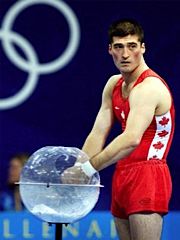 chalk : a grip aid. This works largely by keeping the palms dry and is usually used (in strength training) on exercises such as the deadlift, and the Olympic lifts.
chalk : a grip aid. This works largely by keeping the palms dry and is usually used (in strength training) on exercises such as the deadlift, and the Olympic lifts.
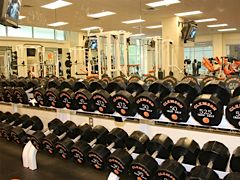 dumbbells : whilst various hand-held weights have been around for a long time, dumb-bells as we now know them are a reasonably recent invention (only a few hundred years or so). Initially, many of these were made by taking two small bells, removing the clappers and affixing the bells to the ends of a bar. They were quite literally dumb bells.
dumbbells : whilst various hand-held weights have been around for a long time, dumb-bells as we now know them are a reasonably recent invention (only a few hundred years or so). Initially, many of these were made by taking two small bells, removing the clappers and affixing the bells to the ends of a bar. They were quite literally dumb bells.
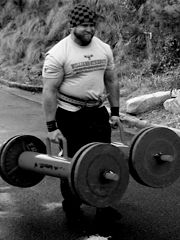 farmer's walk implements : one of the exercises often associated with Strongman training (although it is now used reasonably widely) is the Farmer's Walk; walking a set distance with a heavy object in each hand. Whilst many things are used for this exercise - including the humble dumbbell - it is usually performed in Strongman competitions using a pair of Farmer's Walk implements (pictured). If you've never used them before, think dumbbells on steroids.
farmer's walk implements : one of the exercises often associated with Strongman training (although it is now used reasonably widely) is the Farmer's Walk; walking a set distance with a heavy object in each hand. Whilst many things are used for this exercise - including the humble dumbbell - it is usually performed in Strongman competitions using a pair of Farmer's Walk implements (pictured). If you've never used them before, think dumbbells on steroids.
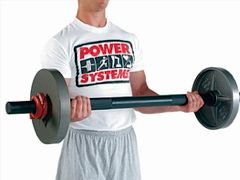 fat bar : nothing terribly complicated here. A fat bar is no more than a thicker version of a standard bar (2 or 3 inches rather than the usual 1 or so). The extra diameter makes it slightly more difficult to hold; providing an additional grip requirement for each exercise.
fat bar : nothing terribly complicated here. A fat bar is no more than a thicker version of a standard bar (2 or 3 inches rather than the usual 1 or so). The extra diameter makes it slightly more difficult to hold; providing an additional grip requirement for each exercise.
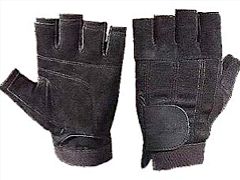 gloves : weightlifting gloves (usually fingerless) simply work to increase your grip. As with belts, these are often used - if at all - only for the heaviest set or two.
gloves : weightlifting gloves (usually fingerless) simply work to increase your grip. As with belts, these are often used - if at all - only for the heaviest set or two.
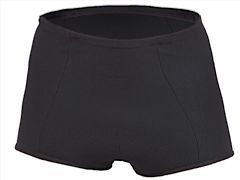 groove briefs : think of them as underwear for your squat suit. Briefs increase hip drive, reduce groin pain (helping you to train through minor injuries) and add to overall stability. Not to mention making putting on your squat suit a little easier.
groove briefs : think of them as underwear for your squat suit. Briefs increase hip drive, reduce groin pain (helping you to train through minor injuries) and add to overall stability. Not to mention making putting on your squat suit a little easier.
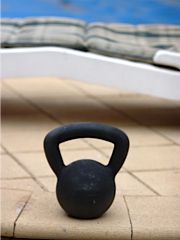 kettlebells : offering an incredible variety of exercises (similar to dumbbells in many ways, with a few bonus features), kettlebells are the ultimate in simplicity. A chunk of iron was never so much fun.
kettlebells : offering an incredible variety of exercises (similar to dumbbells in many ways, with a few bonus features), kettlebells are the ultimate in simplicity. A chunk of iron was never so much fun.
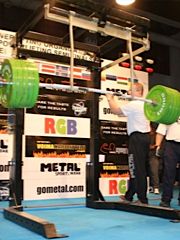 monolift : most notably used by competitive powerlifters, a monolift is a simple mechanical device which takes the walkout away from the squat. The lifter is able to establish their favoured stance beneath the bar (without supporting its weight), before the machine removes its support leaving the lifter to squat as usual.
monolift : most notably used by competitive powerlifters, a monolift is a simple mechanical device which takes the walkout away from the squat. The lifter is able to establish their favoured stance beneath the bar (without supporting its weight), before the machine removes its support leaving the lifter to squat as usual.
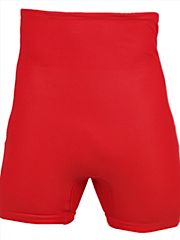 power pants : think of these as the bottom half of a squat suit, with many of the same benefits.
power pants : think of these as the bottom half of a squat suit, with many of the same benefits.
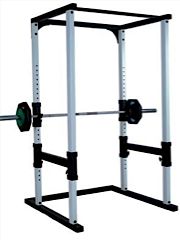 power rack / power cage : a power rack provides a great environment for training numerous exercises in comparative safety. The pins (horizontal bars in the sides of the rack) can be easily moved to several heights, enabling the training of a given exercise through a specific range of motion.
power rack / power cage : a power rack provides a great environment for training numerous exercises in comparative safety. The pins (horizontal bars in the sides of the rack) can be easily moved to several heights, enabling the training of a given exercise through a specific range of motion.
This is one of the first items to consider for a home or garage gym (for serious strength training).
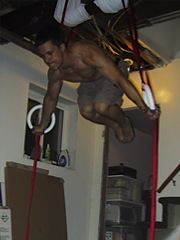 rings : when it comes to upper body strength, ring training delivers in spades. The setup is simple - two rings, each a little larger than a hand, are suspended via long straps. Much more difficult than they look.
rings : when it comes to upper body strength, ring training delivers in spades. The setup is simple - two rings, each a little larger than a hand, are suspended via long straps. Much more difficult than they look.
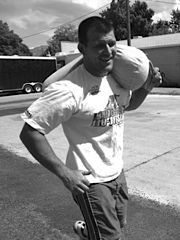 sandbag : exactly what it says - a bag of sand. Large, heavy and difficult to grab hold of - perfect.
sandbag : exactly what it says - a bag of sand. Large, heavy and difficult to grab hold of - perfect.
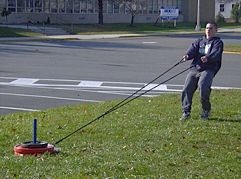 sled : a platform designed to carry various heavy objects, towed by a rope or equally strong strap. Most commonly tied to the waist when running, it can also be dragged in truck pulling style.
sled : a platform designed to carry various heavy objects, towed by a rope or equally strong strap. Most commonly tied to the waist when running, it can also be dragged in truck pulling style.
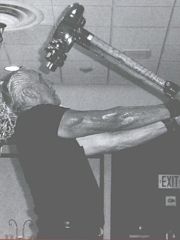 sledgehammer : used for levering (pictured), holds and conditioning work. Excellent for building wrist strength.
sledgehammer : used for levering (pictured), holds and conditioning work. Excellent for building wrist strength.
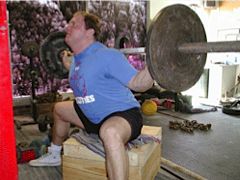 squat box : a box squat (which is actually the search term that initially brought me to tsampa.org) is a squat which is performed by sitting back onto a box before standing once again. The box used for this is usually below the lifter's knee height, and often used for other exercises such as several varieties of jumps.
squat box : a box squat (which is actually the search term that initially brought me to tsampa.org) is a squat which is performed by sitting back onto a box before standing once again. The box used for this is usually below the lifter's knee height, and often used for other exercises such as several varieties of jumps.
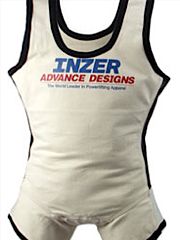 squat suit : functioning in much the same way as a bench shirt, a squat suit essentially makes squatting a little more difficult on the way down and assists on the way up.
squat suit : functioning in much the same way as a bench shirt, a squat suit essentially makes squatting a little more difficult on the way down and assists on the way up.
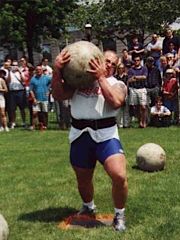 stones : if you've ever watched a Strongman competition, chances are you've seen people pick up a series of heavy stones. Whilst these go by several names, they share the simplicity of being a large, heavy, difficult object to lift. Great to watch.
stones : if you've ever watched a Strongman competition, chances are you've seen people pick up a series of heavy stones. Whilst these go by several names, they share the simplicity of being a large, heavy, difficult object to lift. Great to watch.
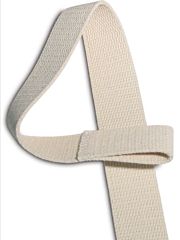 straps : these reduce the need for grip strength in a number of exercises (most things involving a bar) by shifting the supporting role up to the wrists. They're most commonly seen in use with exercises such as shrugs, deadlifts and rows.
straps : these reduce the need for grip strength in a number of exercises (most things involving a bar) by shifting the supporting role up to the wrists. They're most commonly seen in use with exercises such as shrugs, deadlifts and rows.
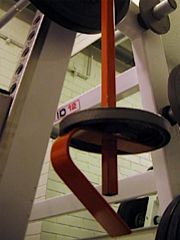 weight releasers : these perform a simple function; most commonly used with the bench press, they add weight at the start of the lift and fall off (under control, of course) when the bar is near enough to the floor. This 'drop off' height is adjustable, enabling targeting of sticking points.
weight releasers : these perform a simple function; most commonly used with the bench press, they add weight at the start of the lift and fall off (under control, of course) when the bar is near enough to the floor. This 'drop off' height is adjustable, enabling targeting of sticking points.
As you have no doubt guessed, the pressing part of the exercise suddenly feels a whole lot easier.
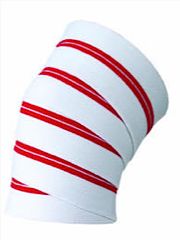 wraps : wraps are usually used to support the knees when squatting, and sometimes the elbows or wrists during exercises such as the bench press. They provide support (whilst allowing sufficient flexibility to perform the exercise) and - in some cases - heat.
wraps : wraps are usually used to support the knees when squatting, and sometimes the elbows or wrists during exercises such as the bench press. They provide support (whilst allowing sufficient flexibility to perform the exercise) and - in some cases - heat.
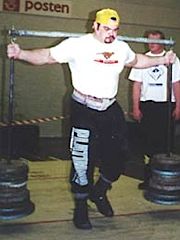 yoke : Norwegian Strongman Roy Holte demonstrates the yoke, which is a simple (but challenging) piece of kit. Stand up so that the bar sits across your upper back, take the weight and walk as fast as you can. Strongman contests involving the yoke are usually timed events performed over set distances with set weights.
yoke : Norwegian Strongman Roy Holte demonstrates the yoke, which is a simple (but challenging) piece of kit. Stand up so that the bar sits across your upper back, take the weight and walk as fast as you can. Strongman contests involving the yoke are usually timed events performed over set distances with set weights.
References
1. The Proper Use of Belts During Weight Training
UPDATE Jan 10, 2007 : Mike suggested a few items from Strongman training and Olympic lifting which have been added.
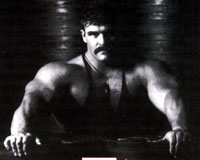



 Tested out a
Tested out a 

 Moved to
Moved to  Decided to
Decided to 

